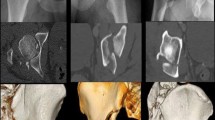Abstract
Introduction:
The Kocher-Langenbeck approach is most frequently used for open reduction and internal fixation of transverse acetabular fractures, the positioning of the patient still falling to the preference of the surgeon. The impact of ‘prone’ and ‘lateral’ positioning on radiographic outcome and postoperative complication rates was evaluated by this retrospective study.
Methods:
Between 2002 and 2007, 27 consecutive cases of transverse acetabular fractures were treated randomly by four attending surgeons at a Level I trauma center, 18 done in a lateral and nine in a prone position, with no significant difference in age and pre- and intraoperative parameters; no patients were excluded. The complication rate was analyzed by medical records. After an average of 9 months postoperatively, the radiographic outcome was evaluated by plain X-rays and computed tomography (CT) scans using the Matta system, the Epstein classification, and the Brooker grades. Post-traumatic arthrosis and avascular necrosis of the femoral head were documented.
Results:
We found a significantly poorer quality of fracture reduction (p = 0.032) and higher rate of posttraumatic arthrosis (p = 0.049) for patients who were operated for transverse acetabular fracture in the lateral versus the prone position. No revision surgery was needed; no infection was detected overall, whereas two iatrogenic nerve damages (one temporary, one persistent) were found only in the lateral group. There was no significant difference concerning extensive blood loss, femoral head necrosis, Epstein grades, heterotopic ossification, and secondary surgery needed.
Conclusions:
The weight of the leg may make reduction more difficult in the lateral position, leading to a poorer radiographic outcome.
Similar content being viewed by others
References
Judet R, Judet J, Letournel E. Fractures of the acetabulum: classification and surgical approaches for open reduction. Preliminary report. J Bone Joint Surg Am 1964;46:1615–46.
AO-ASIF. Home page at: http://www.ao-asif.ch/wps/portal/ Home.
Letournel E. Acetabulum fractures: classification and management. Clin Orthop Relat Res 1980;151:81–106.
Letournel E, Judet J. Fractures of the acetabulum, 2nd edn. Berlin: Springer, 1997.
Matta JM. Fractures of the acetabulum: accuracy of reduction and clinical results in patients managed operatively within three weeks after the injury. J Bone Joint Surg Am 1996;78:1632–45.
Langenbeck B. Chirurgische Beobachtungen aus dem Kriege. Berlin: Hirschwald, 1874.
Kocher T. Operative surgery, 3rd edn. London: Black, 1911.
Mehlman CT, Meiss L, DiPasquale TG. Hyphenated-history: the Kocher-Langenbeck surgical approach. J Orthop Trauma 2000;14:60–4.
Ziran BH, Schlatterer DR, Harris RM. Acetabular reconstruction: fixation methods in simple fracture patterns. In: Smith WR, Ziran BH, Morgan SJ, eds. Fractures of the pelvis and the acetabulum. London: Informa HealthCare, 2007:169–84.
Ditzen W, Börner M. Behandlungsstrategien bei Azetabulumfrakturen. Trauma und Berufskrankheit 2003;5:83–91.
Matta JM, Merritt PO. Displaced acetabular fractures. Clin Orthop Relat Res 1988;230:83–97.
Leite JPB, Pedro ACG, Goldstajn F, Guimaraes JM. Fixação percutânea da coluna anterior utilizando parafusos não-canulados guiado por intensificador de imagens: descrição da técnica. Revista do INTO 2005;3:41–7.
Epstein HC, Wiss DA, Cozen L. Posterior fracture dislocation of the hip with fractures of the femoral head. Clin Orthop Relat Res 1985;201:9–17.
Brooker AF, Bowerman JW, Robinson RA, Riley LH Jr. Ectopic ossification following total hip replacement. Incidence and a method of classification. J Bone Joint Surg Am 1973;55:1629–32.
Tscherne H, Pohlemann T. Tscherne Unfallchirurgie, Becken und Acetabulum. Berlin: Springer, 1998.
Mould RF. Introductory medical statistics, 3rd edn. Bristol: Institute of Physics Publishing, 1998.
Giannoudis PV, Grotz MRW, Papakostidis C, Dinopoulos H. Operative treatment of displaced fractures of the acetabulum. A meta-analysis. J Bone Joint Surg Br 2005;87:2–9.
Oh CW, Kim PT, Park BC, Kim SY, Kyung HS, Jeon IH, Cheon SH, Min WK. Results after operative treatment of transverse acetabular fractures. J Orthop Sci 2006;11:478–84.
Chiboub H, Lamrani O, Kharmaz M, el Yazidi A, Wahbi S, el Manouar M. Transverse and T fracture with fractures of the posterior wall of the acetabulum. Results of orthopedic and surgical treatment. Apropos of 52 cases. Ann Chir 1998;52:913–7.
Ruggieri F, Zinghi GF, Montanari G, Benghi M. Transverse fractures of the acetabulum. Ital J Orthop Traumatol 1986;12:25–40.
Glas PY, Fessy MH, Carret JP, Béjui-Hugues J. Acetabular fractures: therapeutic outcome in 60 consecutive cases. Rev Chir Orthop Reparatrice Appar Mot 2001;87:529–38.
Roetman B, Seybold D, Keil D, Muhr G, Möllenhoff G. Langzeitergebnisse nach Azetabulumfrakturen unter Berücksichtigung von heterotopen Ossifikationen. Zentralbl Chir 2006;131:188–93.
Mayr E, Braun W, Kögl F, Rüter A. Approach-related results following acetabular fractures. Orthopäde 1997;26:384–93.
Madhu R, Kotnis R, Al-Mousawi A, Barlow N, Deo S, Worlock P, Willett K. Outcome of surgery for reconstruction of fractures of the acetabulum. The time dependent effect of delay. J Bone Joint Surg Br 2005;88:1197–203.
Collinge CA, LeBus G, Archdeacon M. Effects of operative positioning on the surgical results of transversely oriented acetabular fractures performed via the Kocher-Langenbeck approach: lateral versus prone position. In: OTA Meeting 2007.
Author information
Authors and Affiliations
Corresponding author
Rights and permissions
About this article
Cite this article
Negrin, L.L., Seligson, D. The Kocher-Langenbeck Approach: Differences in Outcome of Transverse Acetabular Fractures Depending on the Patient’s Position. Eur J Trauma 36, 369–374 (2010). https://doi.org/10.1007/s00068-009-9081-5
Received:
Accepted:
Published:
Issue Date:
DOI: https://doi.org/10.1007/s00068-009-9081-5




